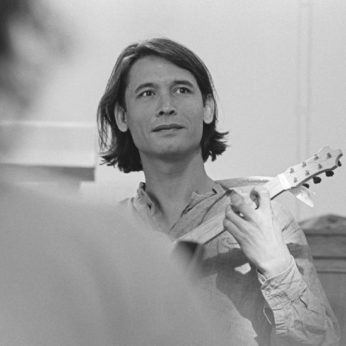Composer: Claudio Monteverdi (b. 1567 - d. 1643)
Performance date: 30/06/2015
Venue: St. Brendan’s Church
Composition Year: 1594-1665
Duration: 00:35:58
Recording Engineer: Richard McCullough, RTÉ lyric fm
Instrumentation Category:Duo
Instrumentation Other: S-solo, chitne
Artists:
Maria Keohane -
[soprano]
Mike Fentross -
[chitarrone]

In an outpouring of emotion, Lettera Amorosa, the faithful messenger
of affection, expresses all the sentiments of loving from afar… bleeding
hearts, beauty, fire, golden rain…the ramblings of a soul lost in the
labyrinth of love. Despite the deprivation of a scenic context, Monteverdi
manages to evoke a real sense of drama in this love letter. It is written in
genre rappresentativo, calling for a
declamatory style that avoids all rhythmic rigidity, something which was still
quite new to audiences in the early 17th century, and certainly had never been
experimented with to such an extent outside the safe haven of the courtly opera
world. Today the love letter is split into scenes, broken up by musical
commentaries reflecting the sentiments. The first of these is Merula’s Sentirete una Canzonetta, a sensual and
flirtatious song based on the teasing nature of love, portraying aspects of the
folk tradition in its rhythmic drive and simple harmonic structure. With its
mention of golden hair ensnaring the heart, it leads nicely into the second
scene of Lettera Amorosa.
Our next interlude introduces the poet,
lutenist and composer Bellerofonte Castaldi, his Cromatica corrente weaving an intricate harmonic tale as our story
unfolds. Rasi’s Indarno Febo returns
to a darker mood, questioning the sustainability of love when parted. Rasi was
best known for his virtuoso singing voice, but his books of songs are among the
first collections of monody that we possess. Piccinini’s Toccata XI for chitarrone solo leads us into the third scene of
Monteverdi’s Lettera Amorosa.
Despite his Austrian name, Kapsberger was
born and educated in
During his lifetime he gained the reputation as being a brilliant virtuoso of
the lute, and after settling in
in 1605 he began to write and publish multiple collections for the instrument.
Although the lute was in favour at the time as being the instrument of choice
to accompany the new genre of the monodic song, Kapsberger was the one
responsible for ensuring that the lute, theorbo and chitarrone all had bright
futures as solo instruments in their own right. Kapsberger’s ground, aptly
named Kapsberger after himself,
displays an innovative view of harmonic contrasts and rhythmic ingenuity which
earned him much respect in his lifetime.
As with the two previous
songs by Merula, his final work in our programme is taken from Curtio precipiitato, a collection of
solo songs with continuo published in 1638. Merula and his older contemporary
Monteverdi definitely influenced each other in many respects throughout their
careers, and in the case of Chi vuol
ch’io m’innamori, both composers set the text to music, Merula publishing
his version first. The text examines the transiency of life and the
inevitability of death, questioning how we live and love, in a slightly
despondent manner. There is no happy ending to our little pastiche on love.
Copyright © 2025 West Cork Music. All rights reserved.
Designed and developed by Matrix Internet